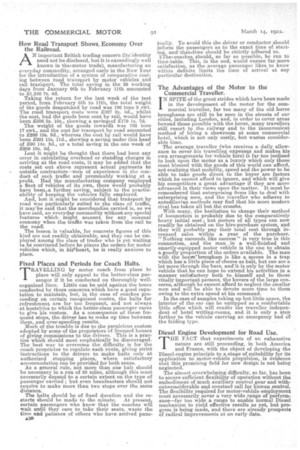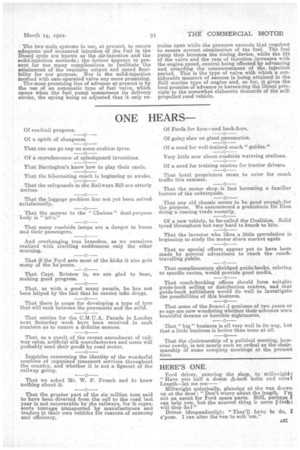What.Are the Safeguards Offered by the Railways?
Page 1

Page 2

Page 3

If you've noticed an error in this article please click here to report it so we can fix it.
N THE memorandum which was issued be, the railway group (and to which publicity was first given by The Commercial Motor with a view to enlightenment of the road transport industry upon the kind of argument which it would be called upon to counter) an endeavour was made to justify the measure, under which powers would be granted to the North-Western and Midland Railways to run road transport independently of their systems, in the light of certain,safeguards which are provided fo. the trading community against therabuse of any powers if granted.
But, those safeguards are devised to prevent the charging of unduly high rates: what the small haulier is afraid of is the power of the railways to grant new exceptional rates, as would be permitted under Sec tion 37 of the Railways Act, 1921. These rates, which may not be less than 5 per cent. nor more than ao per cent, below the standard rates chargeable, are not to be within the control of the rates tribunal, which is held up by the railway group as the authority which shall prevent the small haulier from •being swept off the road by the severe competition of the rail ways.
Traders _must not regard the granting of these exceptional rates as being entirely beneficial to them. They would be so for a time, without doubt, but, when there was no longer any need to fear competition from the displaced independent haulier, the new exceptional rates would be withdrawn and, so long as the effec-t of the increase was not to bring the rates above the point at which the reduction started and so long as those conditions obtained, the trader is expressly debarred the right of objection. So that, in a very little time, he would not only be paying the maximum charge, but would be entirely in the hands of the railway company in all matters of expedition and aoaduct of the traffic.
We have raised, in these' pages, the need, should the powers asked for by the group be granted, for the keeping of separate accounts in respect of the road services as a whole, and, as a reader points out in our correspondence columns, certain provision is made for this, but in the form of accounts required by the Railway Companies (Accounts and Returns) Act of 1911, there is no evidence that the provision is to be made for a correct and proportionate allocation to the road services of the overhead and administrative expenses incurred in respect thereto. How Road Transport Shows,. Economy Over the Railroad. AN important British trading concern (its' identity need not be disclosed, but it is exceedingly well
known in the.motor trade), manufacturing an everyday commodity, arranged early in the New Year for the introduction of a system of comparative costing between road transport by motor vehicles and rail transport. The total saving in the 29 working days from January 9th to February 11th amounted to 21,240 7s. 4d,
Taking the return for the last week of the test period, from February 6th to 11th, the total weight of the goods despatched by road was 196 tons 2 cwt. The road transport costs wore £327 2s. 3d., whilst the eost, had the goods been sent by rail, would have been 2506 3s. 10s., showing a saving..of 2179 1s. 7d.
The weight of the goods inward's was 103 tons 17 cwt. and the cost for transport by road amounted -to 2296 10s. 3d., whereas the cost by rail would have been 2291 13s. 11d., showing a saving under this head of 290 las. 8d., or a total saving in the one week of 2269 16s. 3d.
Lest it might be thought that there had been any error in calculating overhead or standing charges in arriving at the road costs, it may be added that the costs set out above represent actual payments to outside contractors—men of experience in the conduct of such traffic and presumably working at a
profit. Had the manufacturing company employed a fleet of vehicles of its own, there would probably have been,a further, saving, subject to the practicability of keeping the vehicles fully employed.
And, lest it might be considered that transport by road was particularly suited to the class of traffic, it may'be said that the merchandise carried is, as we have said, an everyday commodity without any special features whichmight account for any unusual economy when the traffic was taken from the rail to the roadL The lesson is valuable for concrete figures of this kind are not readily obtainable, and they can be em
ployed among the class of trader who is yet waiting ta be convinced before he places the orders for motor vehicles which, in hie-theart, he is really anxious to place.
Fixed Places and Periods for Coach Halts. TRAVELLING by motor coach from plaice to place will only appeal to the better-class passenger if it be conducted on thoroughly wellorganized lines. Little can be said against the tours conducted by those concerns, which have a good reputation. to maintain, but, in the case of coaches proceeding on certain recognized routes, the halts for refreshment are far too frequent, and not always at hostelries to which the better-class passenger cares to give his custom. As a consequence of these frequent stops, the driver has to make up time between them, and over-speeding results.
Much of the trouble is due to the pernicious custom adopted by some of the proprietors of licen.sed houses of giving commissions to the drivers. This is a practice which should most emphatically be discouraged. The best way to overcome the difficulty is for the coach proprietor to regulate each route, giving strict instructions to the drivers to make halts only at authorized stopping places, where satisfactory accommodation can be provided for both sexes. As a general rule, not more than one halt should be necessary in a run of 50 miles, although this must necessarily depend to a certain extent on the type of passenger carried ; but even beanfeasters should not require to make more than two stops over the same distance.
The halts should be of fixed duration and the restarts should be made to the minute. At present, certain passengers who know that the coaches will wait until they care to take their seats, waste the time and patience of others who have .arrived punc a30 tually. To avoid this the driver or conductor should inform the passengers as to the exact time of start iand'thaartime should be strictly adhered to. Z.The•coaches, should,, so far as possible, be run to time-table. This, in the end, would ensure far more satisfaction, as the average passenger likes to know within definite limits the time of arrival at any particular destination.
The Advantages of the Motor to the Commercial Traveller.
IN SPITE of the great strides which have been made in the development of the motor for the commercial traveller, far too many of the old horse broughams are still to be seen in the streets of our cities, including London, and, in order to cover areas beyond those possible with the horse, many travellers still resort to the railway and to the inconvenient method of hiring a showroom at some commercial hotel, which is not only costly, but wastes considerable time.
The average traveller (who receives a daily allowance to cover his travelling expenses and makes his own arrangements for vehicle hire) is far too inclined to look upon the motor as a luxury which only those most blessed with the goods of this world can afford, not realizing that mobility, speed and the power to be able to take goods direct to the buyer are factors which he cannot afford to ignore, and which will give his competitors a great advantage if they are more advanced in their views upon the matter. It must be remembered that enterprising firms like to deal with enterprising men, and the traveller who adheres to antediluvian methods may find that his more modern rival has taken all but the crumbs. With many, the hesitation to change their method of locomotion is probably due to the comparatively heavy initial cost ; but -motors of all types can now readily be obtained on the hire-purchase system, and they will probably pay their total cost through increased sales within a year of the purchase. "Nothing succeeds like success" is very true in this connection, and the manin a. well-finished and
smartly-equipped motor vehicle is the one to obtain a goodly proportion of the orders available. The man with the horse-brougham is like a mouse in a trap which has a little piece of cheese as bait, but can see a lot more through the bars, ancrit is only by the motor vehicle that he can hope to extend his activities in a manner satisfactory both to himself and to those vitally important persons, the buyers of the large concerns, although he cannot afford to neglect the smaller men and will be able to devote more time to them owing to the extra speed at his command. In the case of samples taking up but little space, the interior of the car can be equipped as a comfortable little office which will render the traveller independent of hotel writing-rooms, and it is only a step farther to the vehicle carrying an emergency bed of the folding type.
Diesel Engine Development for Road Use, THE FACT that experiments of an exhaustive nature are still proceeding, in both America and France, with the object of developing the Diesel-engine principle to a stage of suitability for its application to motor-vehicle propulsion, is evidence that this promising field for new design is not being neglected. The almost overwhelming difficulty, so far, has been to secure sufficient flexibility of operation without the embodiment of much auxiliary control gear and withouticonsiderable and constant call for human control. The flexibility required for motor-vehicle employment must necessarily cover a very wide range of performance—far too wide a range to enable normal Diesel mechanism to yield effective results as yet, but progress is being made, and there are already prospects of radical improvements at an early date. The two main systems in usel at present, to secure adequate and measured injection of the fuel in the Diesel cycle are known as the air-injection and the solid-injection methods ; the former appears to present far too many complications to facilitate the attainment of the requisite output and speed flexibility for our purpose. Nor is the solid-injection method with cam-operated valve any more promising. The most promising line of advance at present is by the use of an automatic type of fuel valve, which opens when the fuel pump commences its delivery stroke, the spring being so adjusted that it only re mains open while the pressure exceeds that required to secure correct atomization of the fuel. The fuel pump then becomes the timing device, while the lift of the valve and the rate of injection increases with the engine speed, control being effected by advancing and retarding the commencement of the injection period. This is the type of valve with which a considerable measure of success is being attained in the Still marine type of engine and, so far, it gives the best promise of advance in harnessing the Diesel principle to the somewhat elaborate demands of the selfpropelled road vehicle.




























